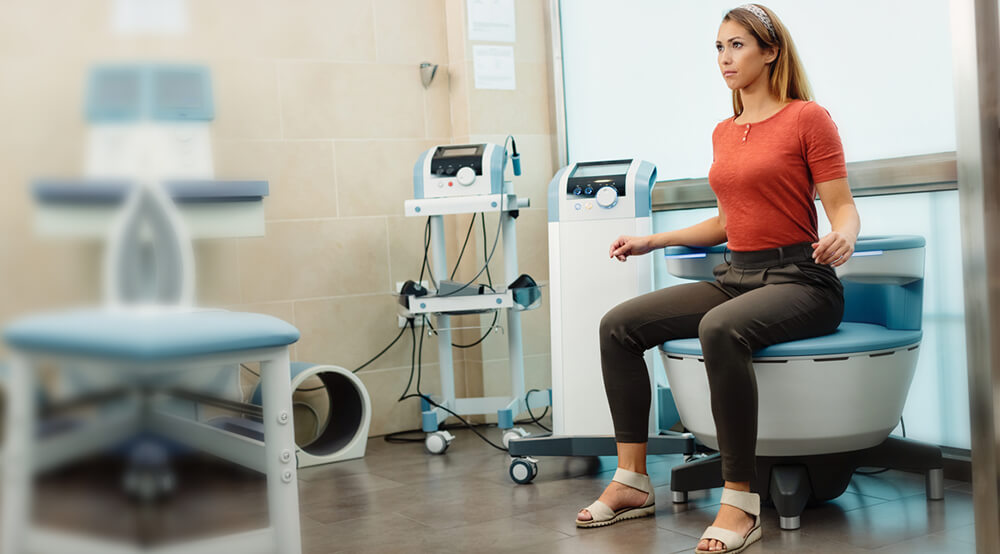You’re not the only one–a quarter to a third of adults in the U.S. suffers from urinary incontinence. This condition increases the risk of urinary tract infections, but it can also significantly impact your personal life.
Incontinence can be caused by an underlying medical condition that may require surgery or medication. However, many cases occur due to a weakened pelvic floor and may require other approaches. In these cases, it can be treated by Emsella, a non-surgical, non-invasive treatment that works by activating and stimulating the pelvic floor muscles through high-intensity focused electromagnetic energy (HIFEM).

How does the urinary system work?
First things first–let’s talk about how the urinary system normally works.
The urinary system includes your kidneys, ureters, bladder, and urethra. It’s in charge of producing, storing, and eliminating waste excreted by your kidneys, also known as urine. Urine is produced in your kidneys by filtering blood and waste products. It then travels from your kidneys through your ureters and fills your bladder. When your bladder is full, you eliminate the waste, or urinate, through your urethra.
Your pelvic floor muscles are also play a role in urinary function. In women, they support the bladder, bowel, and uterus; in men, they support the bladder and bowel. They help control your bladder and bowel movements, and also help your sexual function.
What is incontinence?
Urinary incontinence is a common condition that makes you lose control of your bladder, causing involuntary leaks. There are five types of incontinence:
Stress incontinence
Stress incontinence is the most common type of incontinence. It is caused by weakened pelvic floor muscles, which means they no longer support your pelvic organs properly. This makes you leak urine during movements that put pressure on your bladder, such as coughing, sneezing, or exercising.
Urge incontinence
Urge incontinence is the sudden, intense need to urinate. It usually happens so quickly that you aren’t able to make it to the bathroom in time, and end up leaking. This type of incontinence can be caused by a condition called overactive bladder (OAB), which can occur for different reasons, such as neurological conditions, urinary tract infections, hormonal changes, bladder stones or tumors. It can also be triggered by other factors, like drinking too much caffeine or alcohol, incomplete bladder emptying, or aging.
Overflow incontinence
Overflow incontinence occurs when your bladder isn’t able to empty itself completely, causing it to leak the remaining ruine. In this case, it typically leaks in small, constant drips.
Functional incontinence
Functional incontinence is caused by mental or physical impairments–such as cognitive, neurological, or muscular conditions–that make going to the bathroom difficult.
Mixed incontinence
Mixed incontinence is a combination of stress incontinence and urge incontinence.
What is Emsella treatment?
The Emsella treatment consists of sitting on a device called BTL Emsella that emits high-intensity focused electromagnetic energy, stimulating and strengthening the pelvic floor muscles.
You’ve probably heard of Kegel exercises–well, one 30-minute session of Emsella is equivalent to about 10,000 Kegels.
If you’re wondering if there are any Emsella side effects, the answer is no. It’s a non-invasive procedure that requires no downtime. It’s also painless–most patients describe the sensation as a slight tingling–and you can stay fully clothed during it.
The results: does Emsella really work?
Because every case is different, results from Emsella can vary from patient to patient. Some patients say they feel a difference as early as 24 hours after their first session.
However, for optimal results, our Harvard-trained specialists recommend a series of 6 sessions performed over a period of 3 weeks. Although results are semi-permanent, they also recommend upkeep every 3 to 6 months to maintain long-term results.
The importance of maintaining a strong pelvic floor
Although the Emsella chair drastically improves symptoms of incontinence, there are other things you can do to maximize results and maintain a strong pelvic floor.
For instance, performing pelvic floor exercises (Kegels) can help you maintain everyday control over your bladder.
Additionally, eating a well-balanced diet that helps mantain a healthy digestion also contributes to a healthy pelvic floor. Remember, all your pelvic muscles work together–so poor digestion and constipation add stress to your pelvic floor.
Caffeine and alcohol also affect the way your bladder works, so try minimizing them in your daily life and you’ll see a huge difference.
Regain control of your bladder at Evolution MedSpa Boston
Over 200 million people worldwide are affected by incontinence, but only half of them seek help.
Emsella is changing that. This breakthrough treatment is the most efficient and effective way to treat incontinence and improve your pelvic floor health. It is non-surgical, non-invasive, and has a 95% patient satisfaction rating for a reason.
Are you experiencing any type of leakage or feel like your bladder controls your life? It’s time to make a change! Email us here to book a consultation–our Harvard-trained team is happy to help you recover your quality of life.

Recent Comments